Living In Fear, Helping Your Fearful Dog Gain Confidence
Living a life filled with fear or anxiety is no fun for humans or dogs. In fact, it is a terrible way to live. Feelings of anxiety, nervousness 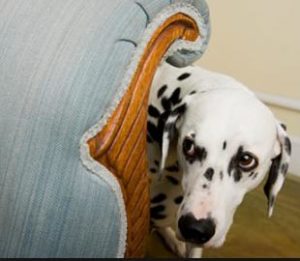 and fear flood the body with toxic chemicals and can shorten a lifespan. Helping your fearful dog gain confidence can be as simple as introducing exercise into their routine, implementing basic obedience skills, coping skills and using something pleasurable (food or toys) to change the way your dog feels about the fearful object or environment.
and fear flood the body with toxic chemicals and can shorten a lifespan. Helping your fearful dog gain confidence can be as simple as introducing exercise into their routine, implementing basic obedience skills, coping skills and using something pleasurable (food or toys) to change the way your dog feels about the fearful object or environment.
When a dog is frightened they may respond in several ways. Fight, flight or freeze. The freeze may only be for a moment and may be  nearly imperceptible to their human owner. Post Freeze the dog may choose to fight or flight. Many a fearful dog choose fight or when on leash, become reactive in an effort to scare off what is scaring them. Reactivity is exhibited in ways such as lunging, barking, growling and even redirecting (biting or posturing) onto their human or other family dog.
nearly imperceptible to their human owner. Post Freeze the dog may choose to fight or flight. Many a fearful dog choose fight or when on leash, become reactive in an effort to scare off what is scaring them. Reactivity is exhibited in ways such as lunging, barking, growling and even redirecting (biting or posturing) onto their human or other family dog.
Fear, anxiety and nervousness can manifest in a dog in many ways.
Aggressive behaviors, panting, drooling, urination/defecation, scratching and other obsessive compulsive behaviors such as licking, chewing, digging, jumping, barking and more.
Does your dog seem anxious, nervous or fearful? Puppies go through a developmental period in which they begin to notice the world around them is bigger than just them and their family. They can be curious but also cautious. Some puppies naturally overcome their initial trepidations and go on to explore the world around them confidently. Yet others are frightened by each new experience, person, dog or even objects such as big trash cans, holiday décor, brooms and more.
Knowing what to do at the first hint of fear or anxiety in your pup can make all the difference. You will need to have patience and know that you can’t rush the process. Fearful dog.
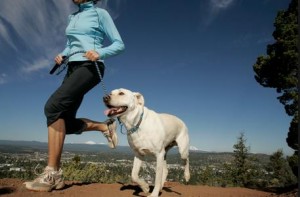 Exercise is very important in relieving stress and anxiety in a fearful dog and humans as well! Exercise such as brisk walking sessions, flood the body with positive, feel good chemicals (endorphins and serotonin). These help to decrease anxiety and stress while helping to promote feelings of well-being and relaxation. If you don’t have time, partner with a professional dog walker to give your dog that much needed positive outlet.
Exercise is very important in relieving stress and anxiety in a fearful dog and humans as well! Exercise such as brisk walking sessions, flood the body with positive, feel good chemicals (endorphins and serotonin). These help to decrease anxiety and stress while helping to promote feelings of well-being and relaxation. If you don’t have time, partner with a professional dog walker to give your dog that much needed positive outlet.
Anything that induces pain or excitement also boosts endorphin levels. Some dogs lick/chew themselves raw or bark excessively at  sights and sounds as a way to cope. In a way “self medicating’ as doing so elevates endorphin levels in the brain. Helping to fill the gap between their boring, frustrating lifestyle and their brain chemistry.
sights and sounds as a way to cope. In a way “self medicating’ as doing so elevates endorphin levels in the brain. Helping to fill the gap between their boring, frustrating lifestyle and their brain chemistry.
Socializing your pup, early, often and for life is important.
Socialization helps your dog become familiar with new things, people, dogs, places and experiences. It can help avoid feelings of fear or anxiety in the first place. Fearful dog tips are helpful.
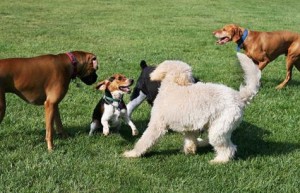 It is essential to keep your dog social throughout their lifetime. Otherwise their social skills can become rusty and when put in a new situation (or one they haven’t been in for a while) can create fear and anxiety in a dog who was never fearful to begin with.
It is essential to keep your dog social throughout their lifetime. Otherwise their social skills can become rusty and when put in a new situation (or one they haven’t been in for a while) can create fear and anxiety in a dog who was never fearful to begin with.
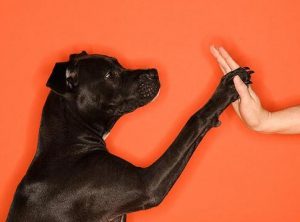 If your dog is already fearful, teaching him basic obedience skills and then employing them when your dog becomes fearful can work wonders. It takes your dog’s attention off that which is scary and refocuses them on something positive that they can do and get a food/toy reward for. If you are unable to get your dog’s focus, move further away from what is scary and try again. Distance = easier.
If your dog is already fearful, teaching him basic obedience skills and then employing them when your dog becomes fearful can work wonders. It takes your dog’s attention off that which is scary and refocuses them on something positive that they can do and get a food/toy reward for. If you are unable to get your dog’s focus, move further away from what is scary and try again. Distance = easier.
Learning simple commands can make a huge difference!
Something as simple as sits, downs and even shake will help your fearful dog when performed repeatedly in a scary situation. This puts their focus on a positive act while giving your dog the chance to learn that nothing bad happened, these things really aren’t scary.
Teach your dog these skills in a non threatening, relaxed environment to start. Then gradually add a very mild stressor or trigger which creates the feelings of fear or anxiety. Gradually over time increase the intensity of the stressor/trigger while working your dog through the command skills learned.
Doing these exercises can create a positive association (changes negative emotions to positive) regarding the person, dog, environment or thing that was once scary and may also boost their confidence in new situations as well.
Think about it… if you were afraid of motorcycles but every time you saw one someone you trusted asked you to perform a simple task AND they gave you $100 for doing so. It would distract you from the scary motorcycle and over time you might feel better about motorcycles. Heck, you might even look for motorcycles so that you could get $100!
If you need help, reach out to a qualified dog trainer or talk to your veterinarian. They are likely to have more helpful information.
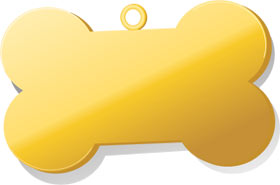






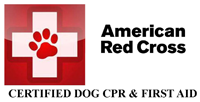



Speak Your Mind